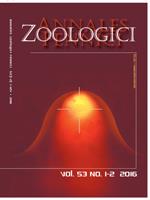Intensive forest management and landscape degradation are threats to amphibian populations. We modelled and compared the extinction and colonization dynamics of the great crested newt in four different spatial contexts that describe landscape change from past to present and future forest landscapes in eastern Finland. In future landscape scenarios, we explored the effects of two forest use intensities with different logging rotation times. The introduction of fish into breeding ponds has been the main cause of local extinctions of the great crested newt. In the future, intensifying land-use and shorter logging rotation will decrease the connectivity between ponds the most. In conservation planning, more attention should be paid to the spatial arrangement of habitat patches, especially if the intensity of human impact will increase. Conservation effort must be targeted towards securing source ponds in the core area and towards enhancing connectivity.
How to translate text using browser tools
8 April 2016
Spatial Context of Breeding Ponds and Forest Management Affect the Distribution and Population Dynamics of the Great Crested Newt
Ville Vuorio,
Pasi Reunanen,
Olli-Pekka Tikkanen
ACCESS THE FULL ARTICLE

Annales Zoologici Fennici
Vol. 53 • No. 1–2
April 2016
Vol. 53 • No. 1–2
April 2016




